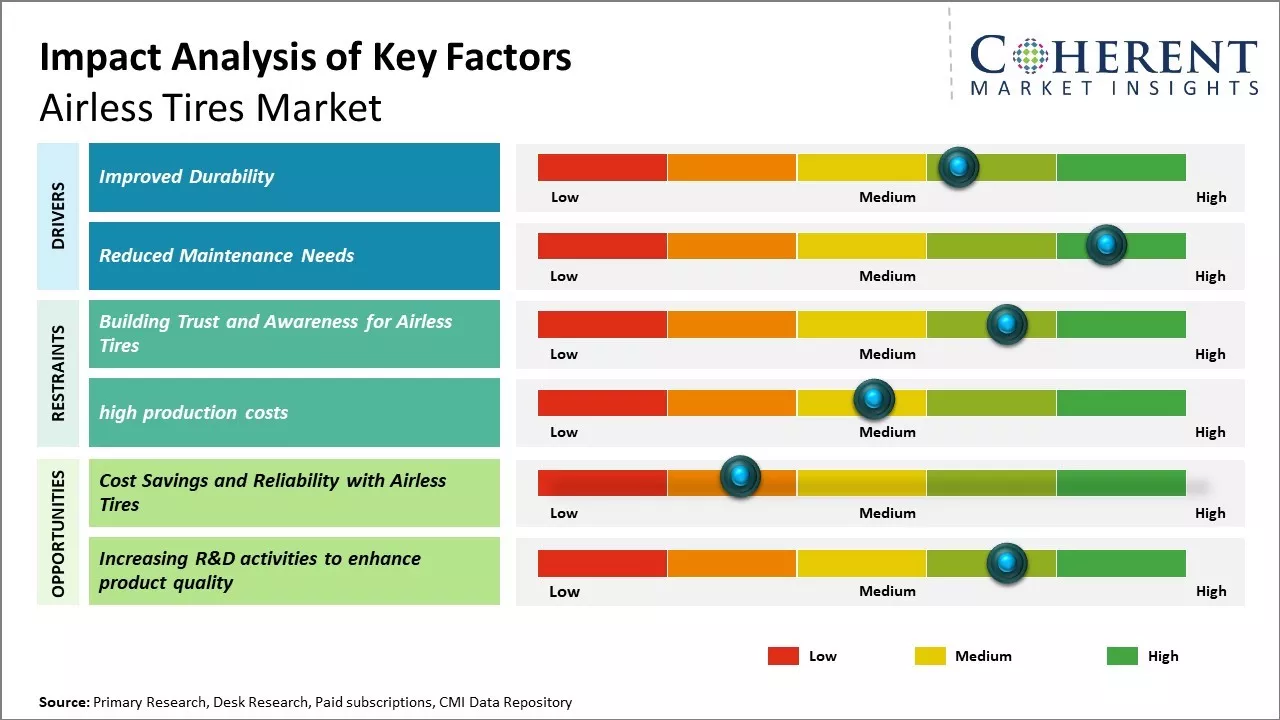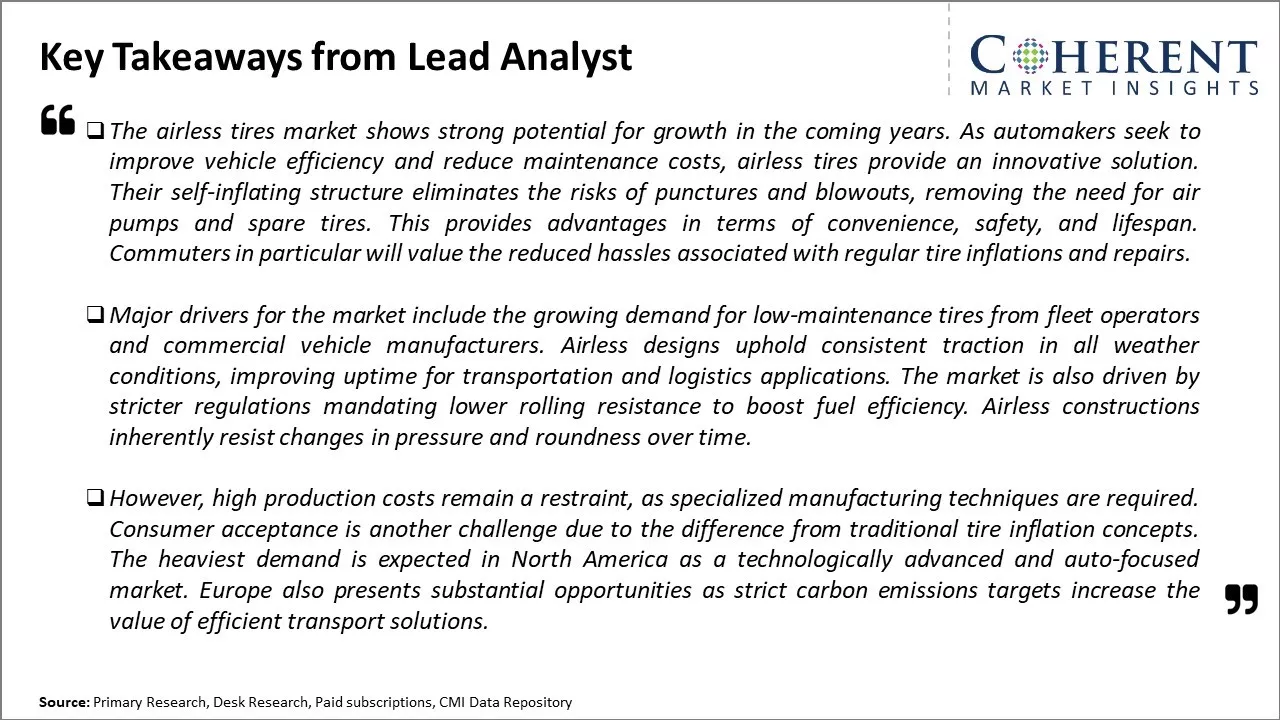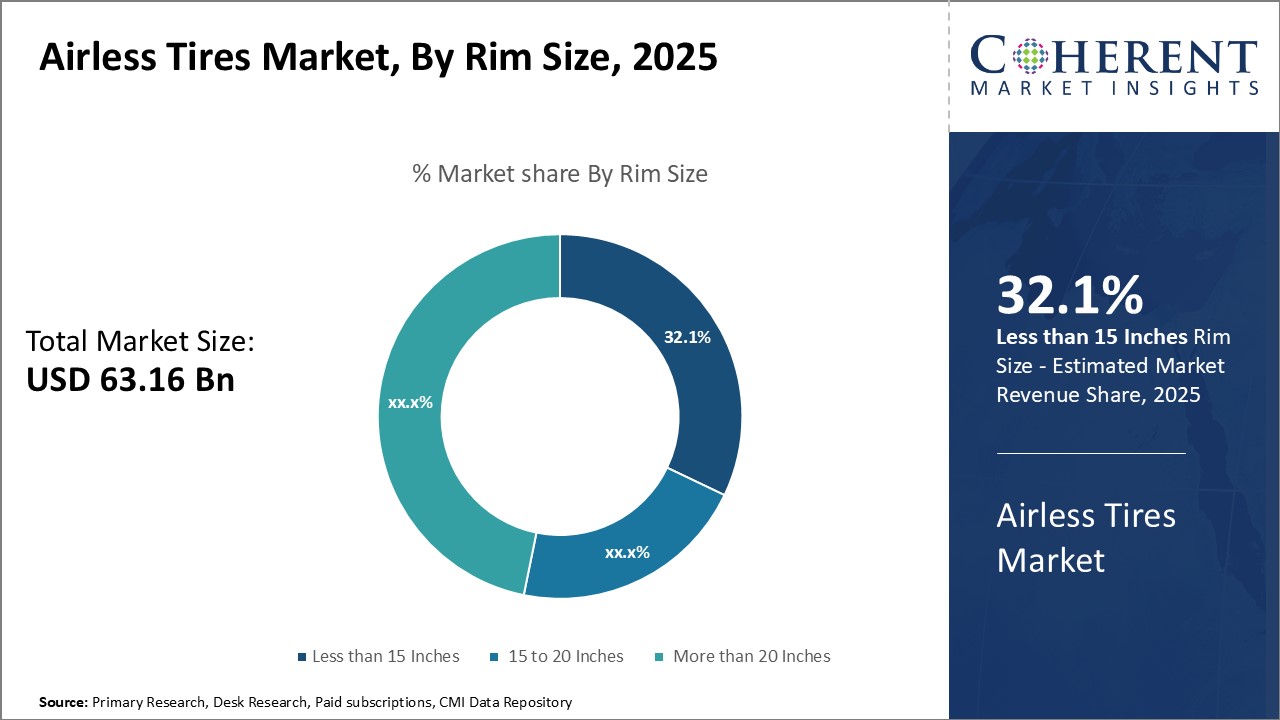Airless Tires Market Size and Trends
Global airless tires market is estimated to be valued at US$ 63.16 Bn in 2025 and is expected to reach US$ 104.17 Bn by 2032, exhibiting a compound annual growth rate (CAGR) of 7.4% from 2025 to 2032.

Discover market dynamics shaping the industry: Download Free Sample
Airless tires does not require inflating or regular maintenance like pneumatic tires. These provide advantages such as better puncture protection and stability. This reduces repair and maintenance costs for consumers.
Global airless tires market is expected to witness significant growth during the forecast period. Rising demand for low-maintenance tires from consumers and increasing sales of premium vehicles equipped with advanced tire technologies are expected to boost demand. Growing focus of OEMs to provide enhanced safety, comfort and drivability is further expected to propel the airless tires market growth until 2032.
Market Concentration and Competitive Landscape

Get actionable strategies to beat competition: Download Free Sample
Improved DurabilityPneumatic tires have issues with punctures, causing breakdown of the tire and damaging the inner tube which needs immediate replacement or repair. Airless tires are made of a solid and flexible rubber material which provides greater durability as there is no air pressure involved. Without any air pressure, these tires are immune to risks like punctures, nails or glass breaking the inner tube. This improves the lifespan of the tires manifolds. Commercial fleet owners will be highly attracted to this benefit as downtime for repairs can become very costly. Airless tires maintain consistent optimal pressure regardless of how they're used, ensuring steady performance for a long time. The solid rubber material is also more resistant to damages from wear and tear on the road that boosts the useful life of these tires. Overall, the elimination of air eliminates the requirements of refilling air or repairing punctures providing improved reliability.
Reduced Maintenance Needs
Conventional pneumatic tires need regular maintenance activities like inspecting the pressure level, checking for any damage to the sidewall or tread, and inflating the air as required. Lack of proper maintenance can result in premature failure or accidents. However, airless tires remove the hassle of inflating air and checking pressure levels altogether. As these tires have no air, their pressure monitoring is not critical. Moreover, the solid material formation makes them durable and long-lasting. This translates to lesser requirements of replacements and repairs over time. For businesses running heavy-duty vehicles on the road, fewer maintenance requirements mean saving money on operating expenses. Fleet managers will appreciate the cost-saving benefits of low maintenance when considering overall ownership expenses. As airless tires does need to be inflated, these can be fitted easily without any special equipment. This convenience further increases their utility. The absence of air pressure related issues eliminates unexpected maintenance and enhances uptime.

To learn more about this report, Download Free Sample
Market Challenges: Building Trust and Awareness for Airless Tires
One of the main challenges faced by airless tires market is consumer acceptance and awareness. As airless tires is a new technology that function quite differently than traditional pneumatic tires, gaining widespread consumer trust and understanding of the benefits may be difficult. Manufacturers will need to clearly demonstrate the safety and performance advantages to convince drivers to switch from well-known standard tire designs.
Market Opportunities: Cost Savings and Reliability with Airless Tires
A major opportunity for the airless tires market is reducing maintenance costs for drivers. When tires get flats or blow out, fixing or replacing them costs a lot. With airless tires, there's no risk of flats or blowouts, so drivers save a ton of money over time on tire maintenance and replacements. This cost savings could be an attractive selling point to boost consumer demand for the new tire technology as it develops.

Discover high revenue pocket segments and roadmap to it: Download Free Sample
Insights, By Rim Size- Durability and load-carrying capacity boosts demand for more than 20 inches tiresIn terms of rim size, more than 20 inches segment is estimated to contribute the highest share of 46,32.1% in 2025 of the market owing to its advantages over smaller-rimmed tires. Larger rims result in tires with thicker tread and sidewall, making them better suited to withstand heavy loads and pounding terrain. Commercial vehicles, off-road vehicles, and luxury SUVs frequently operate under demanding conditions that cause regular wear and tear on standard tires. The extra rubber and reinforced structure of more than 20 inches tires enables them to withstand repeated impacts and endure rigorous use for longer durations. Their heightened sturdiness allows for uninterrupted productivity even in punishing work environments.
Insights, By Vehicle Type- Off-road performance needs favors Off-Road Vehicles
In terms of vehicle type, off-road vehicles segment is estimated to contribute the highest share of 48.8% on 2025 of the market due to requirements for optimized traction and rough terrain maneuverability. All-terrain vehicles, military trucks, and recreational utility vehicles are designed specifically for navigating unpaved surfaces and challenging landscapes where standard passenger tires would struggle to maintain control. The specialized tread patterns, reinforced sidewalls, and elevated ground clearance of off-road vehicle tires provide superior grip over mud, sand, rocks and other unpredictable surfaces. Their enhanced flexibility and shock absorption allows easy steering and movement even in very difficult off-road conditions.
Insights, By Sales Channel- Direct product access boosts OEM segment growth
In terms of sales channel, OEM segment is estimated to contribute the highest share of 69.9% in2024 of the market due to immediate customer interface. Automakers partnering directly with tire manufacturers gain significant leverage in sourcing high quality tires at optimum prices for new vehicle production. This business model offers original equipment fitment with minimal additional assembly costs. As buyers regularly upgrading their vehicles expect tires from the startup, OEM sourcing fulfills consumer expectation of seamless integration. By closely managing the tires they initially fit onto vehicles, automakers can guarantee the right size and load capacity for new models, enhancing safety and performance. Their hands-on approach to tire selection simplifies communication throughout the supply chain.
Regional Insights

Need a Different Region or Segment? Download Free Sample
North America has been dominating with 40.1% in 2025 in the global airless tires market and continues to hold the largest market share due to several factors. The strong presence of automotive and tire manufacturing industry has ensured early adoption of advanced technologies. Several testing and field trials of airless tires conducted by leading automakers like General Motors have generated interest among consumers. With increasing concerns over vehicle maintenance and repair costs, demand for puncture-proof tires is rising steadily.
Higher average income levels in the region allow consumers to pay more for innovative products promising durability and convenience. Countries like the U.S. and Canada have developed infrastructure that is conducive for the use of such specialized tires. With stricter safety standards mandating fitment of appropriate tires, Once airless tires hit mass production, their popularity could soar. People might quickly start using them more once they're widely available. Governments providing incentives for adopting fuel-efficient technologies also favor the long-term growth prospects of airless tires in North America.
The Asia Pacific region has emerged as the fastest growing market for airless tires. Rapid motorization, rising disposability incomes, and expanding middle-class population boosts demand for new age tires. Countries like China, India, and Japan hold a significant presence of tire manufacturers exploring airless tire development. Excellent manufacturing capabilities allow swift integration of latest designs. With Chinese companies aggressively testing various airless prototypes, commercialization could happen faster, giving the region an edge.
Lower raw material and production costs also make Asia Pacific an attractive manufacturing base. As companies test airless tires in different traffic and terrain conditions to confirm their durability claims, consumers are gaining more trust in this technology. Considering the size of vehicle parc and replacement market, even a small fraction of adoption can translate into huge volumes, making Asia Pacific a lucrative market in the long run if challenges around design and performance are addressed. These factors are firmly positioning the region as the new frontier for future growth in the global airless tires market.
Market Report Scope
Airless Tires Market Report Coverage
| Report Coverage | Details | ||
|---|---|---|---|
| Base Year: | 2024 | Market Size in 2025: | USD 63.16 Bn |
| Historical Data for: | 2020 To 2024 | Forecast Period: | 2025 To 2032 |
| Forecast Period 2025 to 2032 CAGR: | 7.4% | 2032 Value Projection: | USD 104.17 Bn |
| Geographies covered: |
|
||
| Segments covered: |
|
||
| Companies covered: |
Amerityre Corporation, Bridgestone Corporation, Continental AG, Hankook Tire & Technology Co., Ltd., Michelin, Sumitomo Rubber Industries, Ltd., The Goodyear Tire & Rubber Company, The Yokohama Rubber Co., Ltd., Toyo Tire Corporation, Trelleborg AB, Pirelli, Cooper Tire, and Tannus Ltd. |
||
| Growth Drivers: |
|
||
| Restraints & Challenges: |
|
||
Uncover macros and micros vetted on 75+ parameters: Get instant access to report
Airless Tires Industry News
- In January 2023, Michelin and DHL teamed up to test the UPTIS airless tire on the road. Nearly 50 DHL Express vehicles in Singapore will use these tires for last-mile deliveries by the end of 2023. Starting January 10, the first vehicles began delivering parcels as part of a trial run. The Michelin UPTIS prototype is a durable tire/wheel combo that does not need air, enhancing safety and reducing tire waste due to punctures.
- In April 2023, Michelin successfully tested the UPTIS airless tire at speeds of up to 130 mph, following requests from European law enforcement agencies. These tires were tested on 30 Toyota HiAce DHL delivery vans in Singapore and on the Chevrolet Bolt in 2019 to evaluate their performance. Michelin is discussing potential testing partnerships with Tesla, General Motors, and other automakers to explore various applications. In October 2021, Michelin introduced the UPTIS airless tires made from rubber and fiberglass, promising longer life, fuel efficiency, and recyclability.
- In April 2021, Toyo Tires revealed plans to start making airless tires that does not need air filling. The company aimed to set up a production line for these tires at it Sendai Plant in Iwakuma City, Miyagi Prefecture, and run production tests by 2021.
- In December 2020, Hankook Tire announced that it worked with Eltek, an Indonesia-based company that makes car parts, to create airless tires. It planned to use Eltek's knowledge of polyurethane materials along with Hankook's tire-making skills to make airless tires for electric scooters and other small vehicles.
*Definition: Airless tires market consists of novel tire designs that does not utilize or require air pressure to function. Known for their self-sealing and puncture-resistant properties, airless tires eliminate the risk of flat tires and are less prone to damage. These provide a constant and consistent contact patch for better vehicle control and stability. While more durable than pneumatic tires, airless tires are heavier and more expensive to produce. The airless tires market is growing as automakers seek to enhance safety and reduce maintenance costs.
Market Segmentation
- Rim Size Insights (Revenue, US$ BN, 2020 - 2032)
-
- Less than 15 Inches
- 15 to 20 Inches
- More than 20 Inches
- Vehicle Type Insights (Revenue, US$ BN, 2020 - 2032)
-
- Passenger Vehicles
- Commercial Vehicles
- Off-Road Vehicles
- Sales Channel Insights (Revenue, US$ BN, 2020 - 2032)
-
- OEM
- Aftermarket
- Regional Insights (Revenue, US$ BN, 2020 - 2032)
-
- North America
- U.S.
- Canada
- Latin America
- Brazil
- Argentina
- Mexico
- Rest of Latin America
- Europe
- Germany
- U.K.
- France
- Italy
- Russia
- Rest of Europe
- Asia Pacific
- China
- India
- Japan
- Australia
- South Korea
- ASEAN
- Rest of Asia Pacific
- Middle East & Africa
- GCC Countries
- South Africa
- Rest of Middle East & Africa
- North America
- Key Players Insights
- Amerityre Corporation
- Bridgestone Corporation
- Continental AG
- Hankook Tire & Technology Co., Ltd.
- Michelin
- Sumitomo Rubber Industries, Ltd.
- The Goodyear Tire & Rubber Company
- The Yokohama Rubber Co., Ltd.
- Toyo Tire Corporation
- Trelleborg AB
- Bridgestone Corporation
- Hankook Tire
- The Goodyear Tire and Rubber Compan
- Pirelli Cooper Tire
- Tannus Ltd.
Share
Share
About Author
Gautam Mahajan is a Research Consultant with 5+ years of experience in market research and consulting. He excels in analyzing market engineering, market trends, competitive landscapes, and technological developments. He specializes in both primary and secondary research, as well as strategic consulting across diverse sectors.
Missing comfort of reading report in your local language? Find your preferred language :
Transform your Strategy with Exclusive Trending Reports :
Frequently Asked Questions
EXISTING CLIENTELE
Joining thousands of companies around the world committed to making the Excellent Business Solutions.
View All Our Clients
